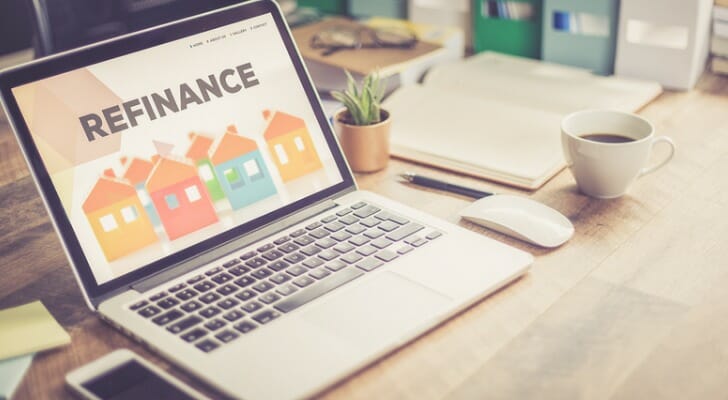Imagine a situation where you could transform your mortgage into a more favorable and empowering financial tool. Or accessing the equity in your property or securing lower interest rates. That’s what’s possible with mortgage refinancing. Refinancing your mortgage is like hitting the reset button on your home loan, allowing you to replace your current mortgage with one that better aligns with your financial goals. Here’s how much it cost to refinance a mortgage and how it works.
For help figuring out how to refinance your mortgage in a way that works for you, consider working with a financial advisor.
Mortgage Refinance Basics
A mortgage refinance refers to the process of replacing an existing mortgage with a new one, typically to take advantage of more favorable terms or to access equity in a property. Refinancing means receiving a new loan to pay off your current loan and obtaining a lower interest rate, longer loan duration or a different type of mortgage. For instance, you might refinance your fixed-rate mortgage to a 5/1 adjustable-rate mortgage (ARM) for a lower interest rate.
Remember, although mortgage refinancing can provide a more favorable loan, it involves closing costs and fees. The general rule of thumb is that you’ll pay between 2% and 6% of the refinance value. As a result, it’s essential to calculate whether the potential savings or benefits outweigh the expenses over the long term.
Average Cost to Refinance a Mortgage
Refinancing a mortgage means paying for the loan servicing required for your original mortgage. While the average refinance costs 2% to 6% of your loan amount, costs vary depending on your circumstances. In addition, when interest rates rise, borrowing becomes more expensive.
Here’s a breakdown of refinancing costs:
- Application fee: $0-$500
- Attorney fees: $500-$1,000
- Credit report fee: $10-$100
- Discount points: 0%-3%
- Document preparation fee: $50-$600
- Flood certification: $15-$25
- Home appraisal: $300-$700
- Home inspection: $300-$500
- Origination fees: 0.5%-2%
- Recording fees: $25-$250
- Reconveyance fee: $50-$65
- Tax service: Varies
- Title insurance and search: $400-$900
Factors Affecting Refinance Costs

Refinancing your mortgage can save you a significant amount of money. However, it’s critical to note that, similar to acquiring a new home loan, a refinance entails closing costs that can impact your immediate and long-term financial situation. Compared to closing on a comparable purchase loan, the closing costs for a refinance are generally lower. The precise amount you’ll be required to pay depends on various factors, such as:
- Your Loan Size: As mentioned above, lenders base mortgage insurance and other costs on your total loan amount. Therefore, the larger your loan, the higher the refinance cost.
- Your Lender: Each lender has its own fee structure. For example, some lenders may waive your credit report or application fee. As a result, it’s wise to shop around for lenders and ask for a summary of fees before committing to a specific lender. This way, you can compare the offers available.
- Your Location: Costs of home inspections, recording fees, taxes and more depend on your location. Therefore, where you live can change your refinance costs by hundreds or thousands of dollars.
- Your Credit Score: Your credit score and history demonstrate your consistency and reliability as a borrower. As a result, your lender charges lower interest rates to customers with higher credit scores because they present less risk. On the other hand, a low credit score means you’ll pay more interest, increasing your refinancing costs.
- Your Home Equity: Similarly, home equity can also impact the interest rates available when refinancing. Generally, lenders offer better rates to borrowers with higher levels of equity. With more equity in your home, you represent less risk to the lender, which can result in more favorable interest rate options.
In addition, the loan-to-value ratio (LTV) is a crucial factor that lenders consider when evaluating a refinance application. You can calculate it by dividing the loan amount by the property’s appraised value. Lenders typically have maximum LTV ratios they are willing to accept. For example, if a lender has a maximum LTV of 80%, they will only refinance up to 80% of the home’s appraised value. So, if your original mortgage required private mortgage insurance (PMI) because you had a low down payment or a higher LTV ratio, refinancing can help you eliminate PMI. Building equity to achieve an LTV ratio of 80% or less can eliminate PMI, reducing your monthly payment.
Your Loan Duration
Refinancing means receiving new terms for your loan. For example, you might extend your loan by five years or more through a refinance. Although doing so can lower your monthly payment, it usually increases the amount of interest you pay over time. On the other hand, shortening your loan duration means paying it off more quickly, reducing paid interest.
Your Type of Mortgage (Fixed-Rate or Adjustable-Rate)
With a fixed-rate mortgage, the interest rate remains constant throughout the entire loan term. The rate you agree upon at the beginning of the loan remains unchanged over the life of the mortgage, whether over 15, 20 or 30 years. This stability allows you to have predictable monthly mortgage payments, making budgeting easier. The downside is your interest rate is permanent, even if market trends in the future produce lower interest rates.
In contrast to fixed-rate mortgages, adjustable-rate mortgages (ARMs) have an interest rate that can change periodically. Typically, an ARM has an initial fixed-rate period, such as 5, 7 or 10 years, during which the interest rate remains stable. This rate is usually lower than fixed-rate mortgages. Then, after the initial period, the interest rate can adjust periodically based on an index, such as the U.S. Treasury rate. Therefore, the interest rate can fluctuate over time, potentially resulting in higher or lower monthly payments. If interest rates rise, your payments may increase, but if rates fall, your payments could decrease.
Your Specific Mortgage Program
In addition, you’ll pay different amounts for mortgage insurance depending on the loan type. For instance, mortgage insurance for conventional loans costs 0.15% to 1.95% of the loan amount every year. For FHA loans, you’ll pay a 1.75% premium upon closing and 0.15% to 0.75% of the loan amount every year. VA loans have a funding fee at closing of 0.5% to 3.6%. Lastly, USDA loans have a 1% upfront fee and a 0.35% annual fee.
Your Type of Property
The type of property you own can impact the refinancing process. Lenders may consider different factors and have specific guidelines based on the property type. Here are a few ways the property type can affect a refinance:
- Primary Residence: Refinancing a primary residence typically offers the most favorable terms and options. Lenders may provide lower interest rates and more flexible terms for primary residences because borrowers prioritize them over other real estate and assets.
- Investment Property: Refinancing an investment property, such as a rental property or vacation home, often comes with slightly higher interest rates and stricter eligibility requirements. Lenders may impose stricter debt-to-income ratios, require larger down payments and assess the property’s rental income potential to determine the feasibility of the refinance.
- Condominiums: Refinancing a condominium may have specific requirements. Lenders may assess the financial health of the condominium association, including factors such as the percentage of owner-occupied units, insurance coverage and reserve funds. Additionally, lenders may have stricter appraisal requirements for condos to ensure the property’s value and marketability.
- Multi-Unit Properties: Refinancing a multi-unit property, such as a duplex, triplex, or apartment building, may involve different considerations. Lenders typically evaluate the property’s rental income potential, occupancy rates and the borrower’s experience as a landlord. The appraisal process may focus on the property’s income-generating capabilities.
- Manufactured or Mobile Homes: Refinancing a manufactured or mobile home may have specific requirements and considerations. Lenders may have stricter criteria for these types of properties due to their unique characteristics. They may require specific certifications, consider the property’s foundation and location and have limitations on the loan-to-value ratio.
Typical Cost Breakdown
Here’s an example of how these numbers work. According to a recent report by Freddie Mac, the average rate refinance is about $273,500. So, here’s how the costs look at percentages of the loan balance on average using the dollar figures introduced earlier:
- Application fee: 0%-0.18%
- Attorney fees: 0.18%-0.36%
- Credit report: 0.003%-0.03%
- Discount points: 0%-3%
- Document preparation fee: 0.018%-0.2%
- Home appraisal: 0.11%-0.25%
- Home inspection: 0.11%-0.18%
- Origination fees: 0.5%-2%
- Recording fees: 0.009%-0.09%
- Reconveyance fee: 0.018%-0.023%
- Title insurance and search: 0.14%-0.33%
Additional Considerations
Here are several other aspects of refinancing a mortgage to contemplate before taking action:
Interest Rates Variations
Interest is the foundation for how lenders make money on loans. As a result, it’s one of the primary expenses for refinanced mortgages. The rate is a percentage of your principal balance, and your monthly payment goes toward interest first, then the principal. As a result, a higher interest rate means you’re paying more for the cost of the loan and less on the loan itself, increasing the cost and requiring more time for repayment.
Choosing Between Fixed-Rate and Adjustable-Rate Mortgages
Remember, a fixed-rate mortgage offers an interest rate that doesn’t change throughout the loan. This feature offers predictability for monthly payments until you repay the loan. On the other hand, adjustable-rate mortgages (ARMs) have interest rates that shift according to market trends after the initial fixed period. The advantage of ARMs is that your initial rate is usually lower than fixed-rate mortgages, and the adjustable rate afterward could also remain lower, increasing your savings.
Potential Savings Over the Long Term
How long you plan to live in your home is another crucial factor regarding refinancing. The refinancing process entails paying closing costs, which can outweigh the savings the interest rate reduction provides. Therefore, it’s best to estimate how long you plan to stay in your home to determine if you can break even or save money through refinancing. One method is to calculate the break-even point by dividing the total cost of the refinance by your monthly savings.
For example, say you save $100 per month, and the closing costs amount to $5,000. In this case, it would take approximately 50 months (or over four years) before you experience savings on your refinance. If you intend to stay in your home for longer than that, refinancing is worthwhile.
Loan-To-Value Ratio (LTV)
The eligibility of your mortgage for refinancing is influenced by the current value of your home compared to the loan amount. During the refinancing process, an independent party appraises your home to determine its market value. The appraised value is critical since the LTV usually can’t exceed 80%. If your home’s value has declined since you purchased it, you might lack sufficient equity to refinance, or you may need to bring additional funds to cover the difference between the home’s value and the loan amount.
Income Stability and Debt-To-Income Ratio
Other debts besides your mortgage, such as car loans or credit card debt, can impact your ability to refinance or the interest rate you receive. Lenders evaluate your debt-to-income ratio when you apply for a refinance. To calculate this ratio, divide your monthly debt payments by your gross monthly income. Generally, a debt-to-income ratio below 43% is desirable for mortgage or refinance qualification.
In addition, your current income and employment status, will influence the refinancing application. Specifically, changes in your income or employment can affect your refinancing eligibility. For instance, you may qualify for a better rate or more favorable terms if your income recently increased.
Conversely, suppose your income has decreased or you recently changed jobs. In that case, the refinancing process may be more challenging, depending on the duration of your current job or the extent of the income reduction. If you’ve recently started a new job, giving your situation several months to stabilize before attempting to refinance can help you qualify for a loan.
Cash-Out Refinance
Freddie Mac’s most recent report shows that 41.9% of refinances in 2021 were cash-out refinances. A cash-out refinance means liquidating a portion of your equity, putting thousands of dollars in your pocket. Homeowners cash out their equity for numerous purposes, such as improving the home, paying off debt, or starting a business. As a result, this refinance enlarges your mortgage, and you get a lump sum in return.
Strategies to Minimize Refinance Costs
Because refinancing can be expensive, it’s recommended to reduce costs as much as possible. This way, excessive fees won’t ruin the benefits of the refinance. These strategies can help you do so:
Shopping Around for Lenders
The whole lending market is open to you when refinancing. Although refinancing with your current lender might be convenient, you could find better rates and terms by getting quotes from several lenders and comparing the offers. This way, you’ll get the best deal available and save money on fees and interest.
Negotiating Fees and Closing Costs
Negotiating fees and closing costs with the lender is also an option. Many fees have wiggle room on the price, so asking lenders about discounts and waivers can be fruitful. In addition, a preexisting relationship with a lender, such as having a bank account or loan beforehand, allows you to access special deals.
Utilizing Mortgage Points
Lastly, you can purchase mortgage points to reduce your interest rate. Typically, they cost 1% of the loan amount per point. As a result, you can cut your interest rate down by paying several thousand dollars up front, reducing interest payments over time. It’s crucial to calculate when you break even if you do so. For example, say you spend $1,500 to lower your interest rate by 1%, lowering your monthly payment by $50. In this scenario, it will take 30 months to break even.
Hidden Costs to Be Aware Of
In addition, some refinancing costs are less apparent when shopping lenders. Here’s what to keep an eye out for:
- Loan duration and its impact on costs: Generally, the longer the repayment schedule, the more expensive the loan. Your loan duration affects how long the interest rate builds upon the principal. So, repaying the loan faster means fewer compounding periods, which equates to less interest accrual.
- Tax implications: Both original and refinanced mortgages provide a tax deduction for paid interest. In addition, purchasing points for a refinance loan creates another tax deduction. Specifically, you’ll divide what you paid over the number of years for the loan. So, paying $1,000 for a mortgage point for a 10-year loan results in a $100 deduction every year.
- Costs associated with mortgage insurance: Refinancing with a conventional loan can incur mortgage insurance costs if you have less than 20% equity in your home. Specifically, private mortgage insurance (PMI) charges a percentage of your loan amount. These charges can occur at closing and each month as part of your loan payment.
The Bottom Line

Mortgage refinancing can benefit homeowners by allowing them to take advantage of more favorable terms and access equity in their property. However, it’s vital to carefully consider the costs involved in the refinancing process and determine whether the potential savings or benefits outweigh these expenses in the long term. As a result, it’s necessary to understand how numerous factors, including the loan amount, origination fees and discount points, can impact the overall cost of refinancing and evaluate the potential savings. Other considerations include the option of a cash-out refinance, which allows homeowners to access their equity, and using strategies to minimize refinance costs.
Tips for Refinancing a Mortgage
- It’s a good idea for homeowners to analyze their financial situation and goals before refinancing their mortgage. Fortunately, you can consult with a financial advisor to evaluate your circumstances and make informed decisions that align with your long-term plan. Finding a qualified financial advisor doesn’t have to be hard. SmartAsset’s free tool matches you with up to three vetted financial advisors who serve your area, and you can have a free introductory call with your advisor matches to decide which one you feel is right for you. If you’re ready to find an advisor who can help you achieve your financial goals, get started now.
- The real estate market fluctuates daily, making it challenging to understand when refinancing is beneficial. You can get an interest rate estimation using SmartAsset’s rate comparison tool to see if the market conditions suit you.
Photo credit: ©iStock/cnythzl, ©iStock/Daenin Arnee, ©iStock/dusanpetkovic
